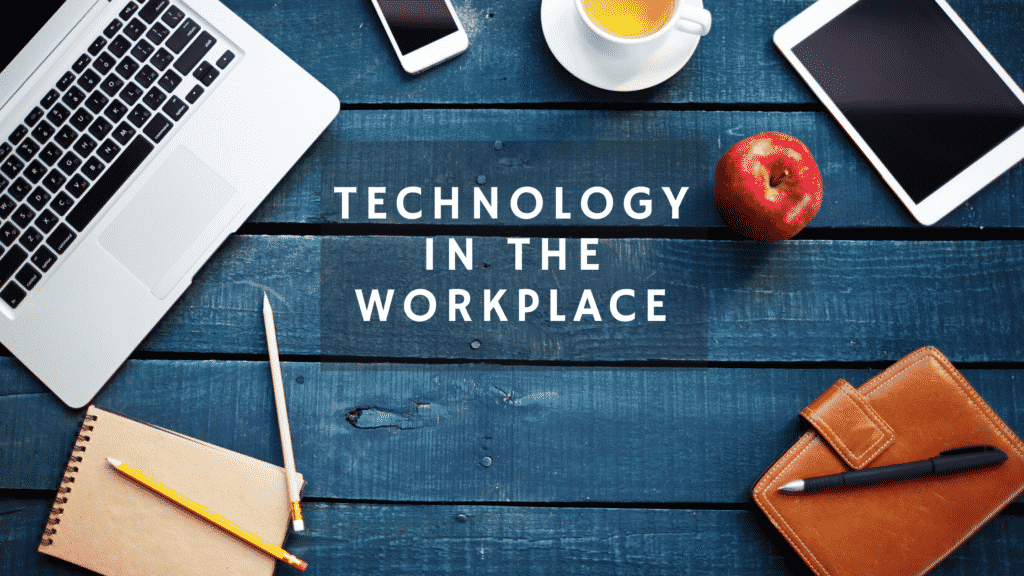An innovative business on the cutting edge of technology is able to empower its remote workers, reap the cost-savings benefits of BYOD policies, and connect its employees no matter how and where they work. It can provide higher-quality products or services, enhance customer service and the user experience, and reduce waste while improving productivity for higher profit margins. All in all, properly utilizing technology in the workplace creates a competitive advantage.
In an incredibly crowded and competitive business landscape, any chance to get ahead is worth capitalizing on. If you’re not taking advantage of the benefits of technology in your organization, you’re likely already falling behind the competition. It’s important to realize that technology in the workplace has become essential for business success.
A Timeline of Technological Advancements in the Workplace
In order to understand how the current impact of technology in the workplace is so strong, let’s look back to see how we got here.
1960s. Technology wasn’t very present in the workplace. Dynamic Random Access Memory (DRAM), a computer chip that drastically changed the evolution of computing power, was invented in 1967 but wouldn’t have a serious effect on companies until years later. The way that people communicated was evolving as more households gained access to televisions and phones, but this was still a challenge for companies. Between the lack of communication tools and infrastructure available, organizations were very limited as to where they could do business.
1970s. Even with the introduction of email in 1971, the impact of technology in the workplace remained stagnant as most large corporations were too focused on revenue to bother trying new tools. However, this decade saw booming technology innovation with inventions such as the daisy-wheel printer, floppy disk, and the first ever video game, Pong. The biggest invention of all arrived in 1973 when Ethernet (which is now the most widely used local area networking (LAN) technology in the world) was invented by Xerox.
1980s. With the rise of tech-giant companies like IBM, Microsoft, Apple, and AT&T, technology in the workplace finally started to gain some traction. The laptop was invented in 1981, and the world’s first cell phone, the Motorola DynaTAC 800x, was launched in 1983. With these new communication tools, organizations were finally able to expand where they could do business beyond their geographic location.
1990s. With the introduction of the World Wide Web in 1989, technology was essentially everywhere by the time the 90’s rolled around. Companies could now use the web to show off their products and services and stay connected with their customers. They could also find and communicate with other suppliers, manufacturers, and distributors that they wouldn’t have been able to previously due to geographic limitations. This became even easier once Google was invented in 1998.
2000s. Google was now used daily by businesses and consumers alike across the globe. Devices such as the Apple iPod and iPhone were created, and social media sites like Myspace and Facebook began to pop up. These innovations started the wave of being able to access everyone and everything online. Consumers were now able to find and contact businesses who offered solutions to their problems, even if they weren’t located close by. At the same time, businesses were now able to do research on their customers to market to them more effectively and create products aligned with their deeper needs.
2010s. We’re all caught up! Welcome to modern times, where technology has become fully integrated into nearly every aspect of both consumers’ lives and businesses’ operations. Workplace trends and business best practices are constantly changing as new technologies are evolving at a rapid pace.
5 Benefits of Technology in the Workplace
There are nearly endless benefits of technology in the workplace that can transform your business into a more successful, mobile, and modern organization. Here are five major ones!
1) The ability to streamline repetitive processes with automation.
Over 40% of workers surveyed in a McKinsey report say they spend at least a quarter of their work week on manual, repetitive tasks such as sending emails and entering data. Leveraging automated technology in the workplace puts these tedious processes on autopilot so your employees can spend more time focusing on higher-return business ventures, such as building new client relationships or providing more attentive customer service. Automated processes are also more accurate. For example, using a software solution to automatically collect, upload, or sync data into a system of record reduces the risk of an employee accidentally inputting the wrong number that could skew an entire data set.
2) Overhead cost savings with remote work and BYOD devices.
Companies of all sizes can experience significant decreases in operating costs by letting their employees work from home and use their own devices. It makes sense—with fewer employees in the office, organizations need less space, materials, and utilities. With BYOD device policies, you aren’t on the hook for purchasing expensive new hardware every time you hire an employee. As a large-scale example, American Express claims their remote work program has not only improved productivity, but also saved $10-$15 million annually in real estate costs. A Cisco study also found that companies save an estimated $3,150 annually per employee that uses their own device between hardware costs, data plans, and the value of time savings.
3) Higher employee productivity and satisfaction.
When you give your employees access to the tools and technologies they need to do their jobs, and let them use them in the way that works best for them, they’ll be more efficient and engaged—and therefore much happier. In fact, highly-engaged business units have 41% less absenteeism, 17% more productivity, and achieve 10% better customer ratings and 20% more sales. When both a higher quantity and quality of work is being produced by your employees, it drives revenue and boosts profit margins. Happy employees are also more likely to stay loyal to your company long-term rather than going to work for the competition, which also saves you on turnover costs.
4) The ability to better serve customers.
Technology in the workplace has allowed businesses to better market to their customers and provide faster and more personalized customer service. From leveraging data to determine where to place targeted ads, to participating in social listening to uncover your customer’s pain points, to providing immediate service through live chat bots or automated emails, and more, there are nearly endless opportunities for technology to enhance your user experience. This can go a long way in differentiating your brand from others, leading to long-term loyalty and higher revenue.
5) The opportunity to tap into non-local talent.
Remote work policies can help businesses break down talent barriers by opening up a wider pool of candidates. Before the rise of remote work, employers were pretty much limited to hiring talent that was already in their local area or willing to relocate for the job—but this usually meant having to reimburse their relocation expenses, which could drastically increase the cost of a new hire. Now, businesses are able to attract and hire the best talent and industry specialists no matter where they live with attractive remote work policies.
Negative Effects of Technology in the Workplace
While there are many benefits of technology in the workplace, it’s important to know what the negative effects can be so you can work to combat them in your modern office. Here are four major side effects of the impact of technology in the workplace.
1) The inability for employees to “unplug” after work.
A strong work/life balance is important for employee productivity, satisfaction, and mental health. When employees are so “plugged in” to their devices for the entire day, it can be difficult to detach and put them down after work hours—especially if they get a late-night email from their boss or can see the notifications popping up on their screen from across the room as they’re trying to unwind. This is especially challenging for remote employees who often feel like they need to be reachable at all times to prove they’re actually working. In fact, Buffer’s 2019 State of Remote Work report found that 22% of remote workers claim their biggest struggle is unplugging after work.
2) Higher loneliness rates for remote employees.
Buffer’s report also found that 19% of remote employees say loneliness is their biggest struggle with working remotely. 17% said it was a lack of communication with their team members. If your remote employees are unhappy and unable to effectively communicate with their coworkers, their productivity and quality of work will suffer, and they’ll likely start looking for another job. To combat these issues and reduce turnover expenses, it’s vital to give your remote employees access to the tools they need to not only do their job, but to build and maintain meaningful relationships with their team members.
3) Cybersecurity threats and data breaches.
Security in “the Age of Mobility” is a challenge for nearly every modern office. Organizations are now using multiple platforms and devices at once to manage various aspects of the business. When employees have access to all this interconnected data, it can expose the business to cybersecurity threats. For example, if a hacker gets into one employee’s user account for a specific software, they’d likely be able to gather data from the other apps it is integrated with. To combat this, make sure your employees are using strong passwords and two-factor authentication for their accounts, and set up administrative controls to limit confidential data access to only those who really need it.
4) Privacy lines can be crossed.
There’s a constant debate over whether employers should be allowed to monitor their employee’s personal social media accounts. If they do have something inappropriate on their profile, can you ask them to take it down if it was posted in their free time? This can be a blurry line that has led some companies to adopt formal social media policies, while others take more of the, “We’re only going to address social media use in the workplace if it starts to affect productivity and performance” stance. There’s no clear answer here—it’s up to each individual organization to determine how they want to handle this (as long as they’re following all privacy laws).
3 Examples of Technology in the Modern Workplace
There are lots of businesses on the cutting edge of technology in the workplace. Here are three examples of organizations using technology in innovative ways to help their employees succeed.
1) HCL Technologies.
HCL Technologies offers services such as IT consulting and remote infrastructure management. They believe in “ideapreneurship,” or empowering their frontline workers to turn their ideas into real value for their clients. To make this possible, HCL has created internal platforms where employees can collaborate to brainstorm and nurture new ideas. For example, their Value Portal is a place to post customer-centric ideas, then enables management to review these ideas. This eventually leads them to implementation. Another platform called Intellectual Property Monetization (IPM) allows employees to submit ideas that they want to be patented, where it then identifies realistic opportunities and supports product design thinking. Overall, HCL has effectively aligned its use of technology with its core values in an exciting way.
2) Salesforce.
Salseforce, a cloud-based software company, debuted a CRM solution called Einstein that uses machine learning to build comprehensive customer profiles based on data, identify crucial touch points in the sales process, and uncover additional sales opportunities. The goal is to make life easier for the sales team, customer service reps, and management. The platform helps salespeople identify areas to drive additional revenue, customer service reps better understand the needs of the customer they’re dealing with, and managers gain deeper insights into the big-picture operations of their department.
3) Unilever.
Unilever, a transnational consumer goods company specializing in nutrition, hygiene and personal care products, uses Microsoft technology to connect its global team of nearly 155,000 employees. They utilize Microsoft 365 (a bundle of services that includes Windows 10 and productivity apps such as SharePoint, Word, and PowerPoint) and collaboration tools such as Teams and Yammer. These tools effectively empower their remote employees to connect with one another to share information and ideas. Unilever leadership claims this suite of tools has made a huge impact on productivity and collaboration in the workplace.
The Impact of Technology in the Workplace
Overall, the impact of technology in the workplace is incredibly strong. There’s now an application, software, or platform that can help enhance almost any business initiative—whether that’s to foster collaboration between remote employees, improve customer satisfaction, build a stronger company culture, drive revenue, or eliminate wasteful inefficiencies.
If you aren’t taking advantage of the benefits of technology, your business can quickly become stagnant or even worse, fall behind the competition. In a world where organizations are rapidly investing in new workplace technologies and adopting the latest and greatest business tools, this can be incredibly detrimental.
Ignoring future workplace trends and being slow to implement technology in the workplace can give your competitors who have prioritized getting ahead of the curve a huge advantage over you. This can negatively affect workplace morale, decrease revenue, and give your brand a poor reputation amongst consumers.
So, do you want more efficient employees who are able to produce both a higher quantity and quality of work? Are you looking to improve engagement and job satisfaction to reduce turnover costs and keep your top talent working for you? Is driving revenue and business growth a major goal for your company? If you want to accomplish these objectives, having access to the right is absolutely necessary. Ready to get started?
At Protected Trust, we simplify technology in the workplace while empowering people to communicate so they can achieve their greatest potential from anywhere on the planet. We do this with a vision of a modern workplace, built on an ecosystem of Microsoft Teams and the Microsoft 365 platform.
If you’d like to learn more about how implementing Microsoft technology in your modern office can help transform collaboration, mobility, and security, schedule an introduction with one of our experts today!









